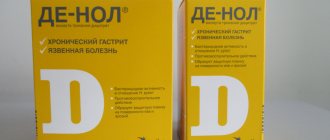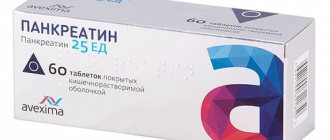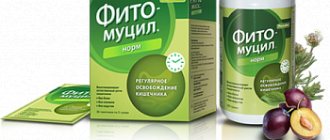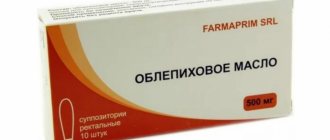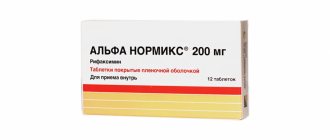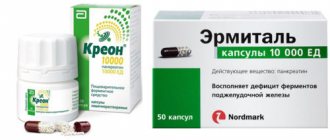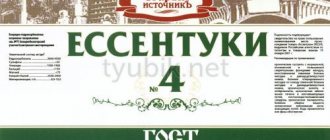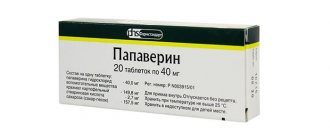De Nol, composition and action
De-nol for stomach treatment
The main component of this drug is bismuth tripotassium dicitrate, which has protective properties, that is, it perfectly covers the surface of the damaged area in the stomach, thereby protecting it from the effects of gastric juice. Thanks to this action, ulcers and wounds heal much faster. In addition, the drug has a good bactericidal effect. It kills harmful bacteria such as Helicobacter.
If we talk about how the drug acts when it enters the body, the scheme is something like this: Some time after taking the pill, the drug enters the stomach. It promotes the formation of a very thin protective film on those areas that are affected by ulcers. Thanks to this action, these areas become invulnerable to the effects of gastric juice, pepsins and other enzymes that are produced during the digestion process, and thus heal much faster.
In addition, the preparation contains components that have an excellent effect on Helicobacter bacteria, which, as scientists have found, are the main cause of the development of diseases such as gastritis and ulcers.
De Nol is prescribed to almost all patients who have stomach problems, since the drug has a very wide spectrum of action. It is often prescribed as one of the components of complex treatment.
Reflux esophagitis. Treatment and prognosis
Treatment corresponds to treatment for GERD (diet, regimen, lifestyle). Some additions should be made regarding drug treatment.
Medication
Prokinetics are drugs that increase the tone of the lower esophageal sphincter and stimulate the evacuation of food from the stomach. The drugs used are: Cerucal, Ganaton, Reglan, Motilium. These drugs enhance the motility of the esophagus, stomach, and duodenum and do not affect the condition of the small and large intestines; they have an antiemetic effect.
Antacids are drugs that suppress the secretion of hydrochloric acid and stomach enzymes, adsorb bile, enzymes of intestinal contents, and have an enveloping effect. Preparations containing hydroxides and oxides of aluminum and magnesium (Almagel, Maalox, etc.) are more often used. They are taken 30 minutes before meals or 1-1.5 hours after meals, at night or at any time for heartburn, pain in the sternum and epigastric region. Antacids containing alginic acid salts (Gaviscon) are used after meals or at night. Drugs prescribed for reflux of bile into the esophagus are ursodeoxycholic acid antacids (Ursofalk, Ursosan), sorbents and enveloping agents (smecta, flax seed, cholestyramine, alginic acid salts).
Cytoprotectors are agents that increase the resistance of the mucous membrane of the esophagus and stomach to damaging factors (Sucralfate, De-nol, Rebamipide), astringents and enveloping agents (bismuth preparations, Vicalin).
The choice of drugs depends on the severity of clinical manifestations and can be used in monotherapy (one drug) or a combination of drugs (antacids, prokinetics, antisecretory drugs) or (prokinetics, bile acid adsorbents, ursodeoxycholic acid), which are the most effective therapy during exacerbations of the disease.
The duration of treatment may take 1-2 months, followed by maintenance or on-demand therapy.
Surgical
Surgical treatment is carried out in case of ineffectiveness of drug therapy, complications of peptic esophagitis, giant hiatal hernias. When the esophagus is narrowed, good results are possible with a combination of antisecretory therapy and bougienage (dilation) of the esophagus.
To assess the effectiveness of treatment, the disappearance of patient complaints, improvement of the endoscopic picture of the esophagus and stomach, and the results of daily monitoring of intragastric pH (acidity) of the stomach and esophagus are important. It is believed that if less than 50 reflux of gastric contents into the esophagus are recorded during the day and the pH of the esophagus is more than 4, then we can talk about remission of the disease.
Indications for use
As mentioned above, this is one of the most popular drugs for the treatment of diseases of the digestive system. De Nol is recommended for use if a person has:
- Stomach ulcer
- Duodenal ulcer
- Gastritis
- Irritable bowel syndrome
- Dyspepsia
Each of these diseases requires its own approach to treatment and the prescription of those dosages that will have a positive effect.
Stomach ulcer
Ulcers form on the gastric mucosa, which over time cause great discomfort to the person. One of the main reasons for the formation of ulcers is the presence of Helicobacter bacteria in humans, which increases the acidity of gastric juice. Also, the main causes of peptic ulcer disease include:
- Constant stress that adversely affects the entire body as a whole
- Poor nutrition, which causes stomach problems
- Taking medications that affect the gastric mucosa
- Diseases of the gastrointestinal tract that can cause ulcers
- Genetic predisposition
- Bad habits such as alcohol abuse and excessive smoking
The main symptoms of gastric ulcer include:
- Constant pain that does not go away even after taking painkillers
- Vomit that has a sour smell and taste
- Frequent heartburn
- Seasonality of pain. Patients often notice that exacerbations occur in the autumn or spring months
If we talk about pain, patients note that they appear after or during meals. They don't bother them on an empty stomach. Very often, eating light porridge that envelops the stomach or a glass of milk helps relieve pain. One of the clear signs that a person has an ulcer is relief from drinking soda, as it reduces acidity in the stomach. De Nol has an excellent effect on ulcers, and besides, Helicobacter bacteria are not resistant to it. Therefore, in most cases, those people who took this medicine as prescribed by a doctor feel relief. Sometimes they even note that pain does not appear for quite a long period of time.
Description of the drug
De-Nol is an antacid drug
De-Nol is a medicine whose main purpose is to combat ulcerative diseases of the gastrointestinal tract. These include:
- aggravated gastric and duodenal ulcers
- chronic gastritis and acute gastroduodenitis
- irritable bowel, mainly accompanied by signs of diarrhea
- functional form of dyspepsia
The drug also has bactericidal activity against Helicobacter pylori, bacteria that often infect the stomach and duodenum and cause various diseases: gastritis, ulcers, duodenitis. Bactericidal activity is the ability of a drug to cause the death of bacteria that come under its influence.
De-Nol is an astringent drug that has a multifaceted effect on peptic ulcers at different stages of their development, the active substance of which is bismuth subcitrate. The drug has the following pharmacological effects:
- astringent effect
- antimicrobial effect
- gastrocytoprotective effect
The astringent effect of the drug lies in the ability of the active substance to interact with protein, thereby forming chelate compounds. As a result of this interaction, a protective film is formed, and only in areas affected by ulcerative erosion. This eliminates the negative effects of the acidic environment of the stomach and ultimately contributes to faster scarring of the lesions.
The antimicrobial effect of De-Nol lies in its ability to reduce the enzymatic activity of microbial cells. This changes the course of their vital reactions and ultimately kills the microorganism itself. In addition, due to the high solubility of the drug, it can penetrate deep into the layers of mucus, killing bacteria that are located under the gastric mucosa. The essence of the gastrocytoprotective effect of the drug is as follows:
- formation of a protective mucosal-bicarbonate barrier
- improvement of cellular metabolism in the lining of the antrum of the stomach, which increases regenerative
- cell capabilities and accelerates mucosal restoration
- reducing gastric acidity by reducing the secretion of hydrochloric acid by the fundic cells of the organ
De-Nol is an antiulcer drug that has many beneficial properties. This drug creates a protective film around the affected area of the stomach lining, kills Helicobacter pylori bacteria and accelerates the regenerative processes of damaged tissues.
Side effects and contraindications
As mentioned above, despite the fact that De Nol is a very good anti-ulcer drug, it does have certain contraindications. So, taking De Nol is strictly prohibited if:
- There is intolerance to some components of the drug
- Kidney diseases
- Pregnancy and lactation
If we talk about side effects, the main and most common ones will be:
- An allergic reaction that results in skin rash and itching
- Nausea and bowel dysfunction
De Nol is one of the best drugs for the treatment of peptic ulcers and gastritis. Thanks to its bactericidal effect, it is able to act on such an unpleasant bacterium as Helicobater, which causes all of the above ailments. The main thing to remember is that you should never self-medicate. You should take the drug only after a doctor’s prescription and in strictly prescribed doses!
How to take it correctly
De-Nol is prescribed for increased stomach acidity
The drug is recommended for use by adults and children over 14 years of age. The duration of the treatment course, as well as the dosage of the drug, is established by the attending physician depending on the individual characteristics of the patient and the conditions of the disease. Basically, no more than four tablets of the drug are prescribed per day, which are taken in two to four doses.
- Following the first scheme, De-Nol is taken half an hour before eating, one tablet per meal (subject to three meals a day) and one before bedtime.
- According to the second scheme, the medicine is taken twice a day (in the morning and in the evening), two tablets half an hour before meals.
- The drug is taken whole and washed down with a sufficient amount of water. It cannot be chewed or crushed. The use of milk instead of water is contraindicated.
- The full course of use of the drug most often lasts from 4 to 8 weeks, after which it is contraindicated to use other drugs that also contain bismuth for sixty days.
The drug should be used strictly following the recommendations of the attending physician. The course of treatment takes from one to two months and is usually prescribed no more than four tablets per day, taken in two or four doses.
De-Nol
De-Nol ®
(lat.
De-Nol ®
) is a gastroprotective, antiulcer, antibacterial drug.
Composition of the drug De-Nol
Active substance:
bismuth tripotassium dicitrate
(another name is colloidal bismuth subcitrate
or simply
bismuth subcitrate
).
Excipients:
potassium citrate, ammonium citrate, magnesium stearate, corn starch, povidone K30, polacriline potassium, macrogol (polyethylene glycol) 6000, hydroxypropyl methylcellulose.
Available in the form of creamy-white coated tablets. One De-Nol tablet contains 120 mg of bismuth tripotassium dicitrate.
Pharmacological action of De-Nol
De-Nol has a pronounced enveloping effect. In the acidic environment of the gastrointestinal tract, De-Nol forms a protective film on the surface of the damaged mucous membrane of the stomach and duodenum, which promotes scarring of ulcers and protects them from the effects of hydrochloric acid and pepsin. In addition, De-Nol stimulates the synthesis of prostaglandin E2, which in turn stimulates the formation of mucus and the secretion of bicarbonates and leads to the formation and accumulation of epidermal growth factor in the damaged area, which also improves the healing of erosions and ulcers.
Indications for taking De-Nol
- stomach and duodenal ulcer
- gastroduodenitis during exacerbation in patients with peptic ulcer
- gastritis and other gastrointestinal diseases associated with Helicobacter pylori
How to take De-Nol and dosage
De-Nol is taken half an hour before breakfast, lunch, dinner and bedtime, one tablet, washed down with 1 - 2 sips of water.
The duration of treatment is from 4 to 6 weeks. According to indications - up to 8 weeks. After completion of treatment, a break of 8 weeks is required, during which no medications containing bismuth should be taken. When eradicating Helicobacter pylori
De-Nol is used as part of a ten-day complex therapy with the antibiotics metronidazole and amoxicillin (if the latter is intolerant, with tetracycline). The usual dosage of de-nol is one tablet 4 times a day; metronidazole and amoxicillin are taken together with de-nol, 250 mg each at each dose (tetracycline - 500 mg). You can reduce the number of daily medications you take by half by also doubling the dose of each drug. After completion of treatment according to the eradication scheme, in case of multiple, repeated ulcers or a pronounced decrease in protective forces (for example, with long-term use of steroids), it is recommended to extend the use of De-Nol to 21 days.
Comparison of De-Nol with other cytoprotectors
At the Russian State Medical University (Yakovenko A.V. et al.), comparative studies of the four main cytoprotectors used in clinical practice were carried out: De-Nol, sucralfate, misoprostol and pentoxifylline.
Cytoprotectors are usually included in complex treatment regimens for the underlying disease, and in some cases are prescribed as monotherapy. It has been shown that De-Nol has the widest range of cytoprotection mechanisms, in particular, De Nol, unlike the other three drugs listed, increases the synthesis of mucus and bicarbonates, increases the content of epidermal growth factor, inhibits NO synthetase and bacterial adhesion. De Nol, unlike sucralfate, improves microcirculation in the mucous membrane, unlike misoprostol and pentoxifylline, has an antioxidant effect, reduces the activity of pepsin, binds bile acids, selectively binds to the proteins of the ulcer bottom and creates a protective layer - a barrier to H+ diffusion, preventing damage to the area of the gastric mucosa lacking a protective epithelial covering. Unlike misoprostol, De-Nol stimulates the synthesis of prostaglandins. The parameter in which De-Nol is somewhat inferior to one of the indicated agents (sucralfate) is the efficiency of binding bile acids. Based on the results of this study at the Russian State Medical University, it was concluded that De-Nol is a preferable drug in comparison with the mentioned cytoprotectors in the treatment of peptic ulcers and chronic gastritis associated with HP, mucositis associated with the use of cytostatics and infectious diarrhea. De-Nol, as well as sucralfate and pentoxifylline, can be the drug of choice for gastropathy caused by alcohol intake and stress ulcers. De-nol, as well as misoprostol, are the best cytoprotectors for gastropathy caused by taking non-steroidal anti-inflammatory drugs. De-Nol is inferior to other cytoprotectors for reflux gastritis and gastropathy caused by taking cytostatics.
De-Nol is not absorbed into the blood from the gastrointestinal tract. In this case, a very small amount of bismuth can be split off from the colloid and enter the blood, which is then excreted in the urine and its concentration in the plasma quickly decreases after the end of treatment. De-Nol is excreted mainly in feces.
De-Nol in the eradication of Helicobacter pylori
De-Nol tends to accumulate inside Helicobacter pylori
, resulting in the destruction of the cytoplasmic membranes of the bacteria and their death.
Therefore, De-Nol is often used in various Helicobacter pylori
. At the same time, De-Nol, unlike other bismuth-containing drugs, in particular bismuth subnitrate and bismuth subsalicylate, is able to dissolve in mucus, which allows bismuth to penetrate under the layer of gastric or duodenal mucus, where the maximum number of bacteria Hp is located. In addition, bismuth contained in de-nol prevents the adhesion of HP to the epithelium of the gastrointestinal tract.
According to a number of leading gastroenterologists, the additional inclusion of De-Nol in HP eradication regimens significantly increases the frequency of successful HP eradication without an increase in side effects.
Due to the widespread use of anti-Helicobacter pylori treatment and the frequent use of antibacterial therapy for other infectious diseases, the number of patients with antibiotic-resistant strains of Helicobacter pylori
, which has become an important medical problem.
Low- and medium-cost treatment regimens that include reserve antibacterial agents are attracting increasing attention. In Russia,
a multicenter study was carried out to study treatment regimens for Helicobacter pylori infection based on De-Nol, furazolidone, amoxicillin and clarithromycin and the following results were obtained:
- De-Nol 240 mg, furazolidone 100 mg, amoxicillin 1000 mg, all drugs 2 times a day for 7 days, eradication - 71.4%
- De-Nol 240 mg, clarithromycin 250 mg, amoxicillin 1000 mg, all drugs 2 times a day for 7 days, eradication - 93.3%
The study showed that anti-Helicobacter therapy, including De-Nol and furazolidone, can quite effectively solve the problem of eradication of Hp strains resistant to metronidazole, and, given its low cost, without large financial costs (Kalinin A.V.).
Comparative studies have been conducted regarding the use of different anti-Helicobacter therapy regimens in pediatrics
.
Data have been obtained that the use of De-Nol and furazolidone in children is effective, safe, and economically justified.
According to the results of economic examination, both in children and adults, the De-Nol + furazolidone + amoxicillin regimen has the greatest clinical and economic effectiveness
When eradicating Helicobacter pylori, monotherapy with De-Nol is not used
.
only
be achieved when using De-Nol as part of a complex regimen of several drugs. "Maastricht-IV" recommends only four-component regimens with bismuth preparations and, in most cases (not always), as second-line regimens (if the first line fails), alternative, etc. (Isakov V.A.).
HP eradication schemes with De-Nol, published by the manufacturer:
- De-Nol 240 mg, 2 times a day for 1 month; metronidazole 400 mg, 3 times a day for 7 days; Flemoxin Solutab 500 mg, 3 times a day for 7 days; eradication - 81%
- De-Nol 120 mg, metronidazole 400 mg, tetracycline 500 mg, all drugs 4 times a day for 7 days, eradication - 89%
- De-Nol 240 mg, metronidazole 400 mg, clarithromycin 250 mg, all drugs 2 times a day for 10 days, eradication - 95%
- De-Nol 240 mg, 2 times a day, furazolidone 100 mg, 4 times a day, Flemoxin Solutab 500 mg, 4 times a day, take all drugs for 14 days, eradication - 86%
- De-Nol 240 mg, furazolidone 200 mg, tetracycline 750 mg, all drugs 2 times a day for 7 days, eradication - 85%
- De-Nol 240 mg, furazolidone 100 mg, clarithromycin 250 mg, all drugs 2 times a day for 7 days, eradication - 92%
- De-Nol 240 mg, clarithromycin 250 mg, Flemoxin Solutab 1000 mg, all drugs taken 2 times a day for 7 days, eradication - 93%
- De-Nol 120 mg, clarithromycin 250 mg, tetracycline 250 mg, all drugs taken 4 times a day for 10 days, eradication - 72%
- De-Nol 120 mg, 4 times a day, Flemoxin Solutab 500 mg, 4 times a day, omeprazole 20 mg, 2 times a day, take all drugs for 14 days, eradication - 77%
- De-Nol 120 mg, 4 times a day, clarithromycin 500 mg, 2 times a day, omeprazole 40 mg, 2 times a day, take all drugs for 7 days, eradication - 83%
Note. The Scientific Society of Gastroenterologists of Russia recommends slightly different HP eradication schemes (see “Standards for the diagnosis and treatment of acid-dependent and Helicobacter pylori-associated diseases (4th Moscow Agreement) adopted by the X Congress of the NOGR on March 5, 2010”).
Professional medical publications regarding the effectiveness of De-Nol on the gastrointestinal tract
- Yakovenko E.P. Ways to increase the effectiveness of antiulcer therapy. Symposium “Mysteries of gastroduodenal ulcers or how ulcers heal.” 12th Congress of Gastroenterologists of Russia. – M. – 2006.
- Kalinin A.V. Peptic ulcer: from pathogenesis to treatment // Farmateka. – 2002. – No. 9. - With. 64–73.
- Belousova Yu.B., Karpov O.I., Belousov D.Yu., Beketov A.S. Pharmacoeconomics of the use of bismuth tripotassium dicitrate for peptic ulcer disease // Therapeutic archive. – 2007. – No. 2. – T. 79. – p. 1–9.
- Maev I.V. Modern approaches to the treatment of gastric and duodenal ulcers // Treating Doctor. – 2003. – No. 5. – p. 4–8.
- Potapov A.S., Pakhomovskaya N.L., Dublina E.S. and others. Evaluation of the effectiveness and safety of triple eradication therapy for helicobacteriosis in children with the drugs helol, de-nol and flemoxin solutab // Almanac of Clinical Medicine. – 2006. – volume XIV. - With. 87–94.
- Yakovenko A.V., Grigoriev P.Ya., Yakovenko E.P. and others. Cytoprotectors in the treatment of stomach diseases. Optimal approach to drug selection // Experimental and clinical gastroenterology. – 2006. – No. 2. – p.1–4.
On the website GastroScan.ru in the “Literature” section there are subsections “Gastroprotectors, cytoprotectors, hepatoprotectors, esophagoprotectors” and “Diseases of the stomach and duodenum (DPC)”, containing articles for healthcare professionals on relevant topics.
special instructions
- Long-term use of large doses of De-Nol can cause reversible encephalopathy.
- Half an hour before and half an hour after taking De-Nol, it is not recommended to drink any drinks, milk, eat food or antacids.
- Alcoholic drinks are prohibited during De-Nol therapy.
- When treated with De-Nol, black stool is possible.
Side effects:
sometimes nausea, vomiting, increased bowel movements are possible, rarely - skin rash, itching. Taking de-nol often causes a “metallic taste” in the mouth.
During pregnancy and breastfeeding
, as well as in case of impaired renal function, De-Nol is not recommended.
In case of overdose
Reversible renal failure may develop, symptoms of which may appear 10 days or later after taking large doses of De-Nol.
Interaction with other drugs:
De-Nol reduces the absorption of tetracycline. When using De-Nol simultaneously with other drugs containing bismuth, the risk of increasing the concentration of bismuth in the blood increases.
According to the pharmacological index, De-Nol belongs to the group “Antacids and adsorbents”. According to ATC - to the group “Antiulcer drugs and drugs for the treatment of gastroesophageal reflux” and the code A02BX05 corresponds to it.
Disadvantage
De-Nola is its relatively high price.
Manufacturer:
Astellas Pharma Europe B.V. (Astellas Pharma Europe BV), Netherlands.
Manufacturer's instructions
(pdf): “Instructions for medical use of the drug De-Nol.”
Other medicinal products containing active ingredients
bismuth tripotassium dicitrate
currently* registered in Russia: Vicanol Life, Bismuth tripotassium dicitrate, Vitridinol, Novobismol, Ulkavis, Escape, as well as not registered and not currently sold* in the Russian Federation: Ventrisol, Pilocid, Tribimol.
A Ukrainian-made drug not registered in Russia: Gastro-norm. *As of July 2022
De-Nol has contraindications, side effects and application features; consultation with a specialist is necessary.
Back to section
